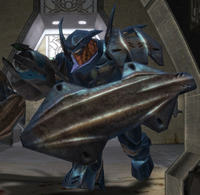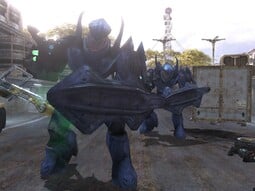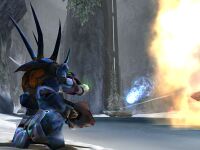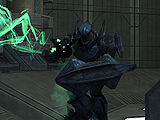Mgalekgolo
From Halopedia, the Halo wiki
Template:Covenant Species Infobox
The Mgalekgolo[1] (meaning "serpent union"[2]) are assemblages of colonies of Lekgolo, a species of small colonial worm like creatures, into a larger, and more powerful organism.
The Mgalekgolo is known as a "Hunter". It's the only Lekgolo form seen in combat, but, actually, it's its least common form, in which the individual Lekgolo form a humanoid shape approximately twelve feet tall, which can then be armed with an Assault Cannon, armored, and turned into an extremely powerful ground unit. This Mgalekgolo form is employed by the Covenant as heavy infantry.
When a single colony of Mgalekgolo becomes too big, the colony will divide in half to create two independent Mgalekgolo colonies. These colonies will share an extremely close and mysterious bond, referred to only as being "bond brothers" or "Mates".[3]. Mgalekgolo that have split into "bond brothers" are recognized by spiked appendages that rise from their shoulders, which means that they are bonded to another Mgalekgolo.[4]
Groups of Lekgolo worms have been observed in the core of all Halo 3 era Scarab walkers, though this type of colony has yet to receive a name.[5]
It is unclear what other types of Lekgolo exist, as these colonial creatures have yet to be directly observed outside of combat.
Background
Hunters take a hulking bipedal form in the Covenant military.[6] In this form, they are the strongest species in the Covenant [7]. These forms stand anywhere from nine and a half to twelve feet tall, but when in their combat state they crouch to approximately eight feet, making their weak spots smaller.
In addition to this, they always fight in pairs making them even stronger foes. Hunters fight with Assault Cannons integrated directly into their armor, and they carry an enormous and nearly-impervious metal shield made of an unknown alloy that they are given from Covenant cruisers, which they sometimes use as a melee weapon.
The Assault Cannon used in Halo 2 is more beam-like, similar to that of the Gravity Cannon. The fire is more sustained, and more devastating. With these weapons and characteristics it seems that the Hunters are more like equipment than soldiers. Many Marines and even some Spartans have died from the weapons wielded by these monstrous Hunters.
The Hunters' religious, political and philosophical affiliation with the Covenant was based on their need for viable space travel and they otherwise see little need for religion. However, at least some appear to truly believe in the promise of the Great Journey.
When their home world of Te was visited by an advanced alien culture which intended on mining the world, they faced heavy resistance from the Hunters whose physiology gave them a tremendous advantage in combat. The Covenant were further infuriated by the Hunters's destruction of Forerunner artifacts during their routine feeding.[8] Hunters were later forced into the Covenant by the superior starship technology of the Elites - on the ground they were mostly, if not always, victorious. Faced with extinction by orbital bombardment, they joined the Covenant.
It is assumed that this is when an Arbiter was killed, and that this was the time of the Taming of the Hunters. Terms for their induction into the Covenant were eventually met despite communication difficulties which hampered the process. As part of joining their conquerors, the Covenant would use local labor and expertise to mine resources from rare metals to minerals. In exchange for this, the Hunters were given free access to the Covenant's space-ways.
Hunters almost never associate, or even communicate, with other Covenant client races, save for the Elites. They are dismissive, scornful, and arrogant to the "lesser" Covenant races like grunts and jackals, and are utterly contemptuous of their foes.
Hunters have three names: personal name, bond name, and line name. The personal name is given at birth. The line name represents the genetic heritage, being the name of the most successful Hunter of his ancestors. If one reaches a certain level of status, his offspring will have his personal name as their line name. The bond name is taken between bonded pairs, a relationship about which little is known, but it appears to be something like a lifelong brother. Examples of names include Igido Nosa Hurru, and Ogada Nosa Fasu.
In Halo: Contact Harvest, it is stated that Mgalekgolo "Brothers" are two pieces of the same colony of Lekgolo that have formed two Mgalekgolo. One that has lost its partner can and will become extremely aggressive. Bonded Mgalekgolo consider themselves brothers and are fiercely protective of each other.
During the Covenant Civil War, most Hunter pairs sided with the Sangheili and the Covenant Separatists. No reason for this is known yet, but it is likely due to their deep respect for the Elites,
During the Battle of Onyx, some Hunters had command of lower ranking Sangheili, possibly signifying some sort of leadership or rank level.
They are called mysteries by an Elite Fleet Commander. It is stated that the Hunters were mysteries, and that the commander had known them to tear opponents apart with their "hands" whilst in a blood frenzy, and then pause to recite war poetry. [9]
Anatomy and Physiology
Hunters are not singular organisms, but rather have creatures composed of multiple small, orange, eel-like beings that form a singular collective consciousness and act as one.
The extremely strong armor that covers them serves the dual purpose of protecting the eels and keeping them together.
Hunters also have very sharp, long spines made of the same eels that compose their body.
Hunters have been known to impale careless Marines upon these spines. However, in-game the spines serve no purpose besides decoration.
The white streak on the Hunter's "head" is actually a visor or sensor screen.
Because of their make up of thousands of small eels instead of being a singular large organism, the Lekgolo are one of the only species in the Covenant, or of the characters in the game that cannot be assimilated by the Flood, as each eel is barely sentient, and are far too small for the Infection forms to burrow into.
As such, there is never a Hunter Combat Form, though it is thought that the flesh of the Lekgolo can and is likely used by the Flood simply for its biomass, and it was also thought that the Flood Juggernaut was The Hunter Form for the Flood, but this was proven false.
The collection of eels that make up a Hunter's body are unintelligent at the most basic level, but can form complex thoughts and emerge as a conscious individual when they combine into larger masses that communicate through chemical and electrical means.
Their society is predominated by this combination of being to create exponentially more intelligent creatures, and the actual "Hunter" organism is one of the rarer and smaller forms to be found, used primarily in interaction with the Covenant hierarchy.
The eels that make up a "Hunter" only have one eye per worm. The worms that make up the arms and legs have the eyes located within the central thorax armor.
The neural net that Hunters develop enables them to be incredibly strong and sensitive to all things within a 1000 foot line pointing out from non-combat form, and a half sphere that extends 500 feet in combat form.
Hunters generally growl during battle but will sometimes talk and make remarks like the other Covenant species. Instead of using vocal chords, they vibrate their bodies to make a low rumble that is described as "more felt than heard" to produce speech.[10]
It is theorized that Hunters reproduce asexually; however, there is, as yet, no way to be certain. New information suggests that the Hunters can generate only one eel, so, an eel from a large number of other Hunters is needed to make a "new" Hunter.
The Hunters' gauntlets have three fingers, each bearing a sharp claw. It appears that they wear their distinctive arm shield by inserting their hand into a built-in gauntlet. Similarly, their Assault Cannon has a large hand slot, enabling the weapon to be attached securely to the arm.
Flood Controversy
It has been speculated that the Tank Form and Juggernaut Forms were infected Hunters, but this has been proven false.
Flood require an adequate source of calcium within the host, and as Hunters lack this mineral in their physiology, Flood are unable to utilize any part of the Hunter.
They also lack a unified central nervous system, being a colony of communicating organisms, and so no single Flood infection form could gain control over the body.
Combat
Halo: Combat Evolved
A Hunter's armor is extremely resilient, and is immune to most small arms fire, as the ammunitions does nothing or even bounces from it.
However, they do have an exploitable weak spot: the exposed orange flesh located in their midsections and necks. While they keep the exposed areas on the fronts of their bodies well-covered with their shields, rarely giving the player an opening unless the Hunter tries to melee them, the creature's backs have a large exposed area that is extremely vulnerable.
In addition, while not on alert to an enemy's presence they assume a stance where their neck and midsection is especially vulnerable. While firearms are incapable of penetrating a Hunter's armor, it cannot stand up to heavy weapons such as rockets and artillery.
In Halo: Combat Evolved, Hunters were rarely difficult to defeat; their AI was simplistic, their shots and melees slow and awkward, and they could barely move fast enough to run down a back-pedaling Spartan.
Interestingly in Halo PC, if you don't move from your position while the Hunter is firing at you, it will never hit you with its Assault Cannon. Furthermore, they could be killed by a single shot from the M6D Pistol, as long as it hit the exposed orange area in the middle of the body or the similarly unarmored "neck".
Other weapons, especially the shotgun and sniper rifle for very short and very long distances, respectively, were equally deadly. The rocket launcher was always effective, but never particularly necessary. Grenades were only moderately effective, as the Hunter could withstand a half-dozen grenade blasts.
Plasma weapons were often ineffective, as was the Needler, and the MA5B Assault Rifle took so long to make a kill that other weapons were far more useful. Still, no player with even a modicum of skill feared confronting a Hunter on open ground.
On Legendary, some players regarded Hunters as the least challenging enemies in the game. However, inexperienced or careless players can fall victim to the Hunters' attacks, which, while easy to anticipate, are rather powerful.
However, Hunters really gained the upper hand in the cramped hallways of the Truth and Reconciliation and the Pillar of Autumn, where there was little space to dodge the fuel rods or crushing melee blows, and no room to utilize either a sniper or rocket launcher to defeat them. Still, these levels were full of shotgun or pistol ammo, and these weapons are reasonably useful against Hunters at close range.
If one were to stand far away from the Hunter, it might bring to bear its Assault Cannon. However, it's projectile has a low velocity, and as such, is very easily dodged. It is also easy to anticipate, as the barrel of the weapon glows bright green before firing. If one were in melee range of the Hunter, it might also wield its shield in as a powerful melee weapon, resulting in serious injury, if not death for the intended target. However, these attacks can be, at times, simple to avoid.
On certain levels, it is possible to defeat Hunters by standing in front of a cliff and then sidestepping them as they attempt a melee attack. If timed correctly, the Hunter, unable to stall its momentum, will fall from the precipice to its death.
Halo 2

The Hunters have undergone a number of changes for Halo 2. For example, they will actually react to the loss of their bond brother. While they appear in fewer numbers, they are tougher and more dangerous.
The most notable change is their new weapon: although similar to the old Assault Cannon, the new Assault Cannon fires a continuous beam of green plasma rather than an arcing projectile. This new weapon is more damaging if not dodged carefully.
In addition, the Hunters are over 25% larger[11] and faster, making combat against them much more hectic. Fortunately, all these go towards your advantage when playing the Arbiter; the Hunters are then powerful and durable allies.
They have gained a new move, too: the ability to attack an enemy behind them. This effectively makes the old strategy of "dodge-and-fire" far less effective.
Finally, the Hunters have much more health. Most small arms do rather moderate damage against them, in contrast to the M6D's ability to kill them in a single shot. For example, on Normal difficulty, it takes 13 shots from the M6C Magnum Sidearm, 6 full bursts from the Battle Rifle, or 10 shots from the Covenant Carbine to kill a Hunter.
On Heroic and lower difficulties, sniper weapons will kill a Hunter in a single shot. However, on Legendary, not a single weapon (except, of course, the Scarab Gun, which is never present during a fight with Hunters anyway) can kill them in one hit. Even a SRS99C-S2 AM Sniper Rifle or Beam Rifle will take two shots to kill a Hunter on Legendary.
Often, the most effective weapon against them is the one that does the most damage: the Rocket Launcher is greatly effective, as is the Fuel Rod Cannon. While these weapons take two and three shots respectively to kill a Hunter on Legendary, they can damage one regardless of where it hits it.
Grenades still do little damage against Hunters, and it will usually take a large amount of them to take one down. However, grenades, hand held or fired from the Brute Shot, will disorient a Hunter, giving the player an opportunity to shoot at its exposed flesh. Perhaps the most effective method to defeat a Hunter would be to stick a plasma grenade to it and shoot it in its exposed back with a beam rifle or sniper rifle.
Hunters are equipped with an extremely devastating Assault Cannon melded into its arm. Unlike a normal Fuel Rod Cannon, Hunters with their cumbersome bulk and strength are able to withstand the recoil and produce a more lasting and lethal blast.
If an enemy gets too close, the Hunter will attempt a clumsy but dangerous melee attack with its shield, severely injuring if not killing the enemy. Once its partner is killed, the Hunter becomes much more aggressive and will chase the player, attempting to avenge its partner's death by only melee attacks.
When battling the UNSC Marines, one Hunter will engage the Marines in close combat, whilst the other will hang back and support with the Fuel Rod Gun. If one of the hunters die, the other occasionally will leap forward and attempt to smash an enemy with its shield. If this attack connects, the foe on the receiving end of the blow will invariably die.
Halo 3

The Hunters in Halo 3 are further upgraded from their Halo 2 counterparts. They are even larger, but appear less bulky.
Their previously vulnerable "stomach" areas are covered by armor plating. All melee attacks are faster and deadlier, and these Hunters now anticipate enemies behind it and can attack them.
If a grenade is thrown at a Hunter, it can strafe-jump away from the explosion. However, their armor now falls off in pieces as the Hunter accumulates damage, and their Assault Cannons do slightly less damage, while it appears that grenades and explosives seem to do more damage compared to the other two games.
Even on Legendary, a single Spike Grenade can kill a Hunter if properly stuck, so that the direction of the spikes will penetrate directly into the Hunter. The most effective weapons against them are Support Weapons and Explosives.
Halo 3 Tactics
- The best way to combat a Hunter is the usage of a high powered weapon, like a Rocket Launcher or Turret weapon.
- Getting behind the Hunters and quickly causing damage to their backs, before evading their strike as they turn around, is a good option.
- For help with a back attack, Allies are good for a distraction while preparing a back-attack.
- At range, Hunters will use their Fuel Rod Cannons, but this is easily avoided by strafing or hiding behind cover.
- Your main priority should be to get behind the Hunter. Melee attacks, the Shotgun, no-scoping with the Sniper Rifle and Spike Grenades are your best bet for taking down a hunter.
- Brute Shots are good as they are usually available and are quite powerful.
Trivia
- In Halo: Combat Evolved if you stand still the Hunters will be unable to hit you with their long-range weaponry. However, this tactic is not recommended in hand-to-hand combat.
- Hunters were first seen by humans in 2537 in Operation: PROMETHEUS.
- Hunters are responsible for security aboard a Covenant Warship. One of their duties is to protect the vessel's Ship Master. Upon failing that, they are to enact revenge on his assassin.[12]
- In Halo: Combat Evolved, if you look closely at a Hunter the orange fleshy parts glow in an on and off pattern. This can be seen more easily in a dark place.
- It is a common mistake to think that Flood infected Hunters become Flood Juggernauts or Tank Forms, but due to their physiology, that is impossible. Unlike humans and the other Covenant species, their physiology does not include a centralized nervous system, making them invulnerable to Flood infection.
- Halo 2 and Halo 3 Hunters will flex their spines upon sighting the Master Chief, unlike their Halo: Combat Evolved counterparts.
- As of Halo 3, despite the Elites possessing Grunt, and Hunter allies of their own, neither appear as anything but an enemy in the game.
- In Halo: The Flood, it mentions that Hunters have skin and a spine. This is incorrect, however, as they were revealed to be a compound of little worm like entities.
- In Halo: Combat Evolved on the Maw (only on Normal difficulty or higher), the Hunters that run out of the café room will occasionally have gray stomachs and grayed armor on their back and spines, as well as a "burned" appearance. It is unknown if this is just a texturing glitch, a model mix up like the "Honor Guard Councilor" at the end of Gravemind (level), or to show that the Hunters have been in combat for a long time.
- At first, Hunters were meant to comprise the whole of Heretic forces on the Gas Mine.[13]
- Ophis means snake. Congregatio means assembly, society, union. Translated it means "assembly of snakes", no doubt alluding to their physical structure.
- In a Bungie Weekly Update, Frank O'Connor said: "Hunter society is complex and we have seen but the tiniest fraction of it. There are some fundamental facts about Hunter biology that mean the combat type is just the tip of the iceberg" [14]. This means, or at least implies, that there are other kinds of Hunters that simply have yet to be seen.
- Hunters do not have a rivalry with another race in the Covenant.
- Spartan William-043 killed a Hunter by ripping out the worms in its body, hinting that Hunters can be killed if too many worms are displaced.
- It is speculated that the Scarab from Halo 3 is actually a giant machine controlled by the worms. Many things support this. One is that there isn't a control center on the new Scarab, another is the spotting of Lekgolos around the control core. Another theory that can support this is that one of the Scarab's main guns appears the same as a giant Assault Cannon. Additionally, even if the whole crew of the Scarab is taken out, the Scarab continues to move around and fire at the enemy, suggesting it is being controlled by something still and if it wasn't controlled by Lekgolo it wouldn't need to shake off the impact, as seen in Halo 3 on the levels they appear on. Also, if you shoot the power core of the scarab, it bleeds the same orange blood the hunter does.
- In Halo 3, if one shoots a dead Lekgolo's exposed orange spots, small black worms will fly out.
- In the Book Halo: The Fall of Reach, Master Chief first deduces the Covenant's caste system when he sees a jackal that had been crushed to death by a hunter's boot.
- One tactic that is present in Halo 1, 2 and 3 is "Hunter Hopping" or "Hunter Jumping". When a Hunter attempt to squash a player, the player counters by leaping into the air. The Hunter hits the player, sending the player flying high into the air. This tactic can only be used on Normal and Easy difficulties, and is not recommended for inexperienced players. It is not recommended for advanced players either, as it serves no real purpose other than to fly to extreme heights. The same effect can be achieved in Halo 3 using a Scarab. By leaping off of the Scarab's weapon platform and onto one of it's knees, (the knee must be moving upwards) a player can be shot into the sky, exceeding the speed of a man-cannon flier.
- It is impossible to kill a hunter with an energy sword or brute shot melee, even though, in theory, it should be able to slice and kill the worms.
- The Hunter Resembles the Hunter enemy from Bungie's older series, Marathon, with the exception of the weapon being mounted on the arm, as opposed to the shoulder.
- If you get behind a Hunter, it will rear back and attempt to melee you.
- In Halo:Ghosts of Onyx a Hunter killed an elite minor by crushing its spine for returning fire instead of getting in line.
- Hunters are the only enemies in Halo 3 campaign that can't be killed with a single hit of a Gravity Hammer. It takes 2 hits to kill one.
See Also
Sources
- ^ Bestiarum
- ^ HBO Forums
- ^ Halo: The Flood
- ^ Halo: Contact Harvest
- ^ Halo 3, The Ark (Level), The Covenant (Level), The Storm (Level).
- ^ Cite error: Invalid
<ref>tag; no text was provided for refs namedBestiarum - ^ Halo 3 Game Guide, http://www.microsoft.com/silverlight/halo3.aspx, On Covenant character page.
- ^ Cite error: Invalid
<ref>tag; no text was provided for refs namedHalo: Contact Harvest - ^ Ghosts of Onyx
- ^ Halo: Ghosts of Onyx, pages 190/191
- ^ The Art of Halo: Creating a Virtual World
- ^ Halo: Ghosts of Onyx, page 190
- ^ "Essentials - Disk Three"
- ^ http://www.bungie.net/News/TopStory.aspx?story=updatefeb03


